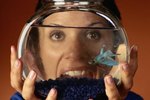
The plecostomus is a member of the catfish family from South America. Care for this freshwater fish is easy, a long as he has sufficient space to accommodate his adult length of 18 inches. A well-cared-for common pleco, as he's also known, should live for between 10 to 15 years in an aquarium; however, you need to watch out for symptoms of freshwater fish diseases. You need to remove carbon filters before medicating for any disease, because the carbon will absorb the medication along with impurities in the water.
Ich
This parasitic disease is also called Ick or white spot. It is a common disease in freshwater fish, but fortunately treatment for it is usually available from pet and aquarium stores. The hallmark symptom of the disease is small white spots, like coarse grains of salt, on the fins and occasionally the body. Ich thrives in water of poor quality. Fishlore suggests heating the tank water to speed up the life cycle of the protozoan, enabling you to kill them off more quickly with medication. It also helps to remove your fish to a quarantine tank while you medicate them for the disease.
Dropsy and Fin Rot
Dropsy and fin or tail rot are bacterial diseases. Bloating and loss of coloration are the main signs of dropsy, which is also called Malawi bloat. Malnutrition is another possible cause of this bacterial infection. Fishlore recommends changing 25 percent of the tank water every two days to clear up the problem. Feeding the pleco better-quality food should also help. If the fish doesn't improve, get medication from your pet store. Tail or fin rot bacterial infections cause lethargy and loss of appetite, as well as signs of rot such as fins that are discolored and appear to be melting. Poor water quality plays a part in this disease, which requires treatment with tetracycline.
Fish Fungus
Fungal growths look like white or grayish growths on the pleco's body, resembling cotton balls. This is a fairly common disease caused by water molds called oomycetes. Often it occurs as a secondary infection to a skin problem. For example, scrapes on a fish's skin provide a breeding place for the fungus. Low water temperatures and infrequent water changes help the fungus multiply. A fungal infection needs medical treatment because it spreads quickly and can cause a secondary fungal infection. Ask at a specialist fish store for the appropriate treatment.
Pop-Eye and Hole in the Head
As the name suggests, the symptom of pop-eye is protruding eyes. Treatments for this bacterial infection include changing the water, providing vitamin-supplemented food and tetracycline. Hole in the head, also called head and lateral line erosion, has no known cause, according to Fishlore. The typical symptom is small indentations or holes on the fish's head. It is thought that a combination of poor water quality, insufficient nutrition and overexposure to activated carbon are the main causes.
References
Photo Credits
-
David De Lossy/Photodisc/Getty Images
Writer Bio
Based in London, Eleanor McKenzie has been writing lifestyle-related books and articles since 1998. Her articles have appeared in the "Palm Beach Times" and she is the author of numerous books published by Hamlyn U.K., including "Healing Reiki" and "Pilates System." She holds a Master of Arts in informational studies from London University.




